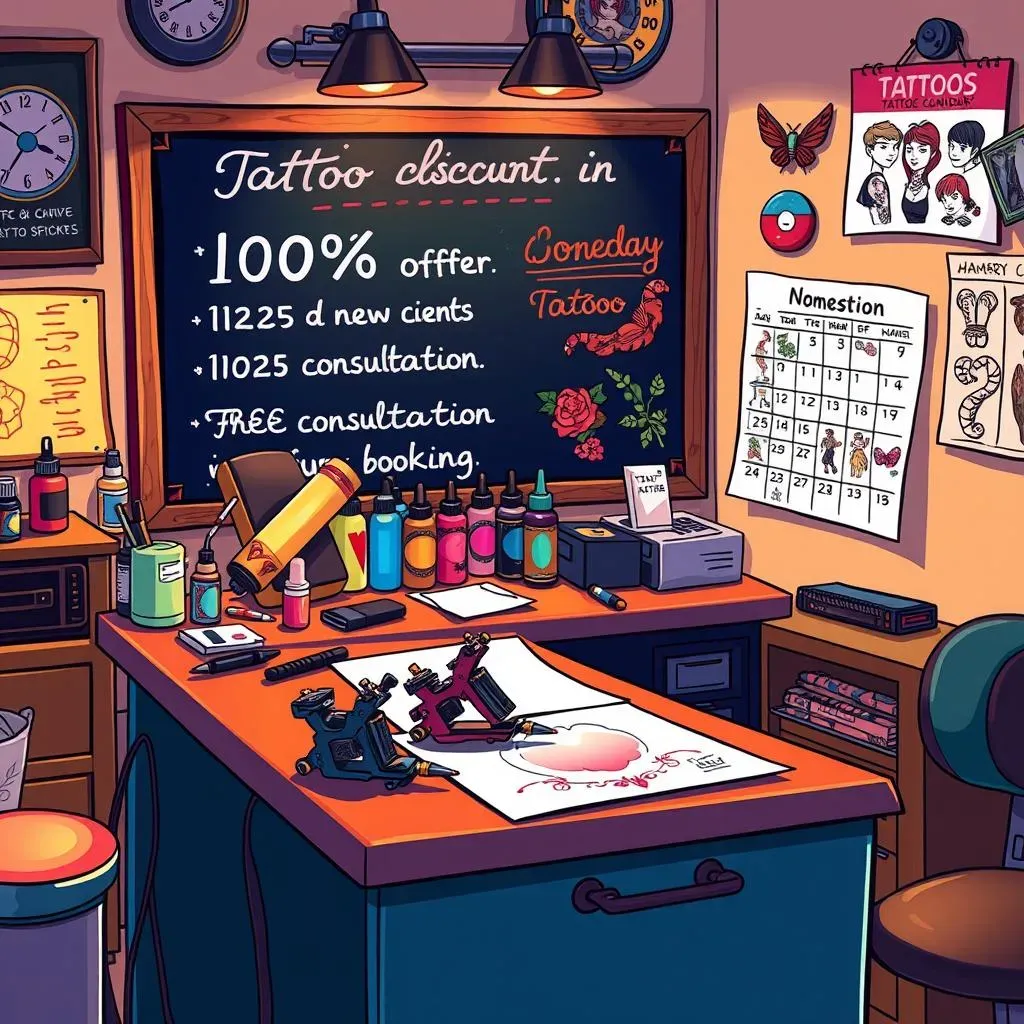Table of Contents
So, you're an artist diving into the world of tattoo design, and the big question looms: how much are tattoo designs really worth? Figuring out the right price can feel like navigating a maze. You want to value your time and talent, but also stay competitive and attract clients. This article will break down the key factors that influence tattoo design costs, from the time you invest to the value the design holds for your client as a permanent piece of art. We'll explore how to assess the competition, understand your client's budget, and meet their expectations when it comes to pricing.
Factors Influencing Tattoo Design Costs
Factors Influencing Tattoo Design Costs
Time Investment: The Core of Your Pricing
Let's be real, time is money. When figuring out factors influencing tattoo design costs, the hours you pour into a design are paramount. A simple flash piece whipped up in an hour? That's different than a sprawling custom back piece that takes days of sketching, revisions, and client consultations. Track your time meticulously, even the back-and-forth emails. This isn't just about the drawing itself; it's about the entire process. Consider this your hourly rate benchmark. What do you need to make per hour to make this worthwhile?
Think of it like this: a freelance graphic designer might charge $50-$100+ per hour. Your design skills are just as valuable, especially when they result in permanent art. Don't undervalue yourself! Factor in the research, the brainstorming, and the refining. Each stage has its own inherent value.
Complexity and Detail: The Intricacies of Art
A tribal armband with bold lines is one thing, but a hyper-realistic portrait with gradients and fine details? That's a whole different ball game. The complexity of the design is a huge factor in determining price. More detail means more time, more skill, and more specialized tools (digital or traditional). Think about the level of shading, the number of colors involved, and the overall intricacy of the piece. A design with delicate linework, complex geometric patterns, or realistic textures will naturally command a higher price than simpler designs.
Consider the tools you're using, too. Are you using specialized software or expensive materials? These costs should be factored into your pricing. The more complex the design, the higher the price should be to reflect the increased time, skill, and resources required.
The Value Proposition: Permanent Art, Lasting Impact
This isn't just a doodle; it's a tattoo! It's going to be on someone's skin forever (or until they get laser removal, which is another story). The permanence of a tattoo design significantly impacts its value. People are willing to pay more for something that will be with them for life. This is where you communicate the emotional value of your work. Is it a memorial piece? A symbol of personal growth? A celebration of something important?
When assessing factors influencing tattoo design costs, remind your clients that they're not just paying for the design itself, they're investing in a piece of art that will tell their story for years to come. This is where your unique style and artistic vision come into play. If you have a distinctive style that clients seek out, you can command a premium price. Highlight what makes your designs special and why they're worth the investment.
How to Price Your Tattoo Designs: A StepbyStep Guide
How to Price Your Tattoo Designs: A StepbyStep Guide
Calculate Your Base Hourly Rate
Alright, let's get down to brass tacks. How to price your tattoo designs: a step-by-step guide starts with knowing your worth. What's the minimum you need to make per hour to keep the lights on and the ramen stocked? Don't just pull a number out of thin air. Factor in your expenses: rent, supplies (digital or traditional), software subscriptions, marketing costs, and, of course, taxes. Then, consider your experience level. Are you a seasoned pro with years under your belt, or are you just starting out? Your experience directly impacts your earning potential.
Once you have a handle on your expenses and experience level, research the going rates for freelance artists and designers in your area. This will give you a baseline for your hourly rate. Remember, your tattoo designs are unique and valuable, so don't be afraid to charge what you're worth. Consider this: if you were doing graphic design work, what would you charge? Tattoo design is a specialized skill, so it's reasonable to charge a premium.
Experience Level | Estimated Hourly Rate |
|---|---|
Beginner | $25 - $40 |
Intermediate | $40 - $60 |
Experienced | $60 - $100+ |
Break Down the Design Process
Now that you have your base hourly rate, it's time to break down the design process into manageable chunks. Think about all the steps involved in creating a tattoo design, from the initial consultation to the final revisions. How much time do you typically spend on each step? Be honest with yourself. It's better to overestimate than underestimate. Here's a sample breakdown:
- Initial Consultation: 30 minutes - 1 hour
- Sketching and Brainstorming: 1 - 3 hours
- Digital Design/Line Work: 2 - 5 hours
- Coloring/Shading: 1 - 4 hours
- Revisions: 30 minutes - 2 hours (per revision)
Once you have a good estimate of the time involved in each step, multiply that by your hourly rate to get the cost for each stage. Add up the costs for all the stages to get the total cost of the design. This is your starting point for pricing your tattoo designs. Remember, this is just a guideline. You may need to adjust your prices based on the complexity of the design, the client's budget, and other factors. But having a clear breakdown of the design process will help you justify your prices and communicate the value of your work to your clients.
Tattoo Design Price List: Examples for Different Sizes and Complexity
Tattoo Design Price List: Examples for Different Sizes and Complexity
so you've got your hourly rate nailed down, and you've broken down your design process. Now, let's talk about real-world examples. A tattoo design price list: examples for different sizes and complexity is crucial for giving clients a clear idea of what to expect. Think of it as a menu of options. This not only sets expectations but also streamlines your consultations. No more vague "how much?" questions – you've got a structured answer ready to go!
The key here is to offer a range of options that cater to different budgets and design preferences. A simple black ink design will obviously cost less than a full-color, highly detailed piece. Consider offering different packages based on size (small, medium, large), complexity (simple linework, shading, full color), and the level of consultation included (basic, detailed, premium). Let's look at some concrete examples. Remember, these are just starting points. Adjust them based on your own hourly rate and experience.
Size | Complexity | Description | Price Range |
|---|---|---|---|
Small (2x2 inches) | Simple Linework | Basic design, minimal detail, one color | $50 - $100 |
Small (2x2 inches) | Detailed, Shading | Intricate design, shading, gradients | $100 - $175 |
Medium (4x4 inches) | Simple Linework | Basic design, minimal detail, one color | $150 - $250 |
Medium (4x4 inches) | Full Color, Detailed | Complex design, multiple colors, intricate detail | $300 - $500 |
Large (6x6 inches+) | Simple Linework | Larger design, basic lines, single color | $300 - $450 |
Large (6x6 inches+) | Full Color, Highly Detailed | Extensive design, many colors, hyper-realistic detail | $500+ (Consultation Required) |
Discounts and Special Offers for Tattoo Designs
Discounts and Special Offers for Tattoo Designs
Attract Clients with Smart Discounts
Let's face it, everyone loves a deal! Offering strategic discounts and special offers for tattoo designs can be a fantastic way to attract new clients, fill slow periods, and build loyalty. But it's crucial to do it in a way that doesn't devalue your work or cut into your profits too much. Think about it: are there times of the year that are slower than others? Maybe January after the holidays, or midweek appointments? These are perfect opportunities to offer a little incentive.
One popular approach is to offer a discount for repeat clients. They already love your work, so rewarding their loyalty is a no-brainer. Another option is to run limited-time promotions, like a percentage off custom designs during a specific month. You could also offer package deals, such as a discount for booking multiple sessions at once. Get creative and tailor your discounts to your target audience and business goals. Just be sure to clearly communicate the terms and conditions to avoid any confusion.
Here's a few discount ideas:
- New Client Special: 10% off their first custom design.
- Referral Program: Refer a friend and both get 15% off.
- Flash Fridays: Discounted flash designs every Friday.
- Birthday Ink: A small discount for tattoos booked during their birthday month.
Bundle Deals and Package Offers
Beyond simple discounts, think about creating bundled deals or package offers to sweeten the pot. Offering a "design and tattoo" package, where the client gets a discount on the overall price if they book the tattoo appointment with you as well, can be a great way to secure both aspects of the business. Similarly, you could offer a "design revision" package that includes a set number of revisions for a fixed price, giving clients peace of mind and preventing endless back-and-forth.
Another compelling option is to create themed packages. For example, you could offer a "memorial tattoo package" that includes a custom design consultation, a detailed sketch, and a high-resolution digital file for the client to keep. Or, you could create a "couples tattoo package" that includes two matching or complementary designs at a discounted rate. The key is to make the packages appealing and valuable to your target audience, while also ensuring that you're still making a profit. Remember to clearly outline what's included in each package and any limitations that apply.
Here's an example of some bundled deals:
Package | Description | Price |
|---|---|---|
The Starter | Design + One Revision | $XXX |
The Standard | Design + Two Revisions + Print | $YYY |
The Premium | Design + Unlimited Revisions + Print + Digital File | $ZZZ |
Navigating Customer Expectations and Budget for Tattoo Designs
Navigating Customer Expectations and Budget for Tattoo Designs
Open Communication is Key
Alright, let's talk about the elephant in the room: money. Navigating customer expectations and budget for tattoo designs can be tricky, but it's crucial for a smooth and successful transaction. The best way to avoid awkward conversations and potential disappointment is to be upfront and transparent about your pricing from the get-go. Don't wait until you've finished the design to drop the bomb – discuss the budget early on, ideally during the initial consultation. Ask your client what their overall budget is for the entire tattoo, including both the design and the application. This will give you a realistic framework to work within.
It also allows you to tailor your design options to their financial capabilities. If their budget is limited, you can suggest simpler designs, fewer colors, or smaller sizes. Conversely, if they're willing to invest more, you can explore more complex and elaborate options. The key is to be flexible and collaborative, finding a solution that meets both their artistic vision and their financial constraints. Remember, a happy client is a returning client!
Here are some questions to ask during the initial consultation to gauge their budget:
- "Do you have a budget in mind for the entire tattoo, including the design and the application?"
- "Are you looking for a simple design, or something more elaborate and detailed?"
- "Are you open to different design options that fit within your budget?"
Value vs. Cost: Educating Your Clients
Sometimes, clients may balk at your prices, especially if they're not familiar with the amount of time and effort that goes into creating a custom tattoo design. This is where you need to educate them about the value you bring to the table. Explain your design process, highlighting the skills, experience, and creativity you bring to the project. Show them examples of your previous work, emphasizing the quality and uniqueness of your designs. Remind them that they're not just paying for a drawing; they're investing in a piece of art that will be with them for life.
Also, be prepared to explain the difference between a custom design and a flash design. Flash designs are pre-drawn and readily available, which means they're typically less expensive. Custom designs, on the other hand, are created specifically for the client, taking into account their individual preferences and ideas. This requires more time, effort, and expertise, which is reflected in the price. By clearly articulating the value of your services, you can help clients understand why your prices are justified.
Conclusion: Find Your Sweet Spot for Tattoo Design Pricing
Pricing tattoo designs is a balancing act. It's about acknowledging your expertise, the time you dedicate to each piece, and the unique value you bring to your clients' vision. By considering the factors we've discussed – time investment, client budget, design complexity, and market rates – you can create a pricing strategy that works for you and your customers. Don't be afraid to experiment, gather feedback, and adjust your rates as you grow and evolve as an artist. Ultimately, the goal is to find that sweet spot where you're fairly compensated for your talent and your clients walk away with a custom tattoo design they absolutely love.